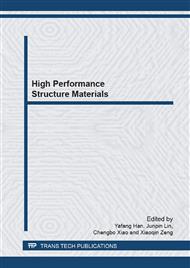[1]
TETSUI T, ONO S. Endurance and composition and microstructure effects on endurance of TiAl used in turbochargers [J]. Intermetallics, 1999, 7: 689-697.
DOI: 10.1016/s0966-9795(98)00085-5
Google Scholar
[2]
TETSUI T. Development of a TiAl turbocharger for passenger vehicles [J]. Materials Science and Engineering A, 2002, 329-331: 582-588.
DOI: 10.1016/s0921-5093(01)01584-2
Google Scholar
[3]
Guo J T. The current situation of application and development of superalloys in the field of energy industry [J]. Acta Metallurgica Sinica, 2010, 46(5): 513-527.
DOI: 10.3724/sp.j.1037.2009.00860
Google Scholar
[4]
WILLS V A, MCCARTNEY D G. A comparative study of solidification features in nickel-base superalloys: microstructural evolution and microsegregation [J]. Materials Science and Engineering A, 1991, 145(2): 223-232.
DOI: 10.1016/0921-5093(91)90252-i
Google Scholar
[5]
ZHENG Y R, RUAN Z C. Investigation on hot cracking of cast K403 superalloy turbine blades, Material Engineering, 1998, (11): 33-37.
Google Scholar
[6]
ZHOU Y Z, VOLEK A. Effect of carbon additions on hot tearing of a second generation nickel-base superalloy [J]. Materials Science and Engineering A, 2008, 479(1-2): 324-332.
DOI: 10.1016/j.msea.2007.06.076
Google Scholar
[7]
ZHANG J, SINGER R F. Effect of Zr and B on castability of Ni-based superalloy IN792 [J]. Metallurgical Transactions A, 2004, 35A(4): 1337-1342.
DOI: 10.1007/s11661-004-0308-0
Google Scholar
[8]
ZHOU Y Z, VOLEK A. Effect of dendrite arm spacing on castability of a directionally solidified nickel alloy [J]. Scripta Materialia, 2007, 56: 537-540.
DOI: 10.1016/j.scriptamat.2006.11.002
Google Scholar
[9]
LECOMTE-BECKERS J. Study of solidification features of nickel-base superalloys in relation with composition [J]. Metallurgical Transactions A, 1987, 19A(9): 2333-2340.
DOI: 10.1007/bf02645057
Google Scholar
[10]
ZHANG J, SINGER R F. Hot tearing of nickel-based superalloys during directional solidification [J]. Acta Materialia, 2002, 50(7): 1869-1879.
DOI: 10.1016/s1359-6454(02)00042-3
Google Scholar
[11]
Eskin D G, SUYITNO, KATGERMAN L. Mechanical properties in the semi-solid state and hot tearing of aluminium alloys [J]. Progress in Materials Science, 2004, 49: 629-711.
DOI: 10.1016/s0079-6425(03)00037-9
Google Scholar
[12]
HATAMI N, BABAEI R, DADASHZADEH M, et al. Modeling of hot tearing formation during solidification [J]. Journal of Materials Processing Technology, 2008, 205(1-3): 506–513.
DOI: 10.1016/j.jmatprotec.2007.11.260
Google Scholar
[13]
WANG Y L, HUANG Z H, ZHANG Q, et al. Effects of chemical compositions on hot tearing of directionally solidified alloys [J] Material Engineering, 2009, (6), 35-38.
Google Scholar


